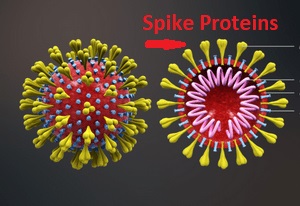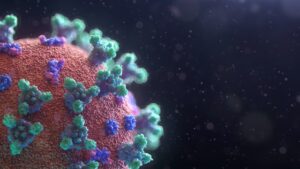
At this point, why should we discuss the coronavirus if we don’t know what it is or more generally, what a virus is, so let’s dive right in and get the answer to this!
What is a Virus?
A virus is not a cell. Cells refer to living organisms, but viruses are not alive. And since they are not living entities, they are parasites that must live within a host to perform their functions. So when we refer to these entities, we will always refer to them as a virus and not as a cell. Now, let’s break down the structure of a virus.
A virus contains a genetic code, called RNA (Ribonucleic acid). RNA is similar to DNA but it contains only one single strand, and it is this code that contains the message to produce proteins that creates the virus. These proteins are called nucleoproteins, which give the virus their structure as well as enable them to replicate.
The RNA contains a blueprint for developing nucleoproteins. When it attacks a healthy cell, it will send in information to that cell to mutate it.
Surrounding the virus is the viral envelope. It protects the genetic code that is within the virus and sets an anchor for its proteins to infect the healthy cells.
Specifics of the COVID-19 Virus
For the coronavirus, spike proteins protrude out from the envelope’s anchor and act as grappling hooks that grab onto the healthy cells and inject the virus’s proteins. The spikes closely resemble a crown, which gives the virus its name “corona” and means “crown” in Latin.
 Given the insights so far, researchers have identified hundreds of coronaviruses. However, only seven of them can infect humans and cause disease.
Given the insights so far, researchers have identified hundreds of coronaviruses. However, only seven of them can infect humans and cause disease.
For decades, coronaviruses have continued to infect humans, such as SARS, and MERS, which infect and damage the lungs. On the other hand, there are four coronaviruses that remain highly contagious -causing infections that lead to common cold symptoms and worse.
The seventh coronavirus SARS-CoV-2 that causes the COVID-19 disease is slightly different as it contains the features of all six coronaviruses. It is highly contagious, fast-spreading, and causes symptoms like the common cold; however, this same virus can infect and damage the lungs. Hence, the seventh coronavirus that has infected humans is of the utmost concern to researchers and healthcare practitioners worldwide.
Given its nature and that the viruses are constantly changing, the mutations in SARS-CoV-2 are critical to researchers. Here we take a closer look at how and why viruses mutate and why the mutation of SARS-CoV-2 is a major concern for global authorities.
The Evolution of Viruses
As a rule, viruses are constantly changing. They replicate and evolve within the host. However, it is important to understand how RNA viruses behave for a better understanding of how viral mutations work.
How do RNA Viruses Behave?
There are two types of viruses:
-
-
- RNA viruses, and
- DNA viruses.
-
RNA viruses tend to be smaller and have fewer genes, making it easier for them to affect several hosts and replicate quickly within their host. On the other hand, DNA viruses are larger than RNA viruses and have a complicated replication mechanism. At the same time, RNA viruses can replicate easily and quickly. Given its speed and nature of replication, when RNA viruses replicate, there is always a potential mistake that can cause changes in the structure of the virus. These mistakes, also known as mutations, lead to variations in the structure and features of the virus compared to the original virus.
Many of these mutations may not affect the properties, structures, and features of the virus, while many mutations can be harmful to the virus. However, a few mutations may make the virus better suited for certain environments, including a new host species. Hence, when an RNA virus enters a new host species and replicates itself, it is more likely to have more mutations to make the virus stronger. It is precisely due to this feature that epidemics like SARS and MERS and pandemics like COVID-19 resulted when the RNA coronavirus spread from animals to humans.
However, the process of mutation doesn’t stop here. Since RNA viruses continue to replicate within humans, they make a variation. While these variations are not robust enough to create a completely new virus, they are certainly strong enough to create new variations, also known as strains. Given these variations during the replication process, we have four variants of concern for COVID-19.
The coronavirus is an RNA virus. However, it is different from other RNA viruses due to its size. It is larger than most of the other RNA viruses, which creates more opportunities for dangerous mutations and the creation of new variations.
Why is Coronavirus Mutation a Concern?

The mutation of SARS-CoV-2 is a concern for global authorities as the persistent changes in the virus are leading to the emergence of new variants. So far, the world has witnessed the emergence of new variants, including Alpha, Beta, Delta, and now Omicron, some of which lead to more severe infections and a higher need for hospitalization. Given the virus’s changes in structure and features, some of these variants have been more successful in transmitting the disease and replicating within the host than the original virus strain.
While words such as mutation can seem terrifying and make you believe that something dramatically different will happen with the emergence of the new variant, that’s not always the case. In most cases, mutations of the RNA virus have little or no immediate effect on its ability to cause disease or more severe disease. However, certain mutations that are strong enough to create new variations can be a threat primarily because the mutations in the virus can make it less recognizable for our immune system. As a result, it is more difficult to fight off the infection.
Another concerning aspect of mutations is that the new variants can make anti-viral drugs and vaccines less effective, leaving individuals more prone to the virus and more severe diseases. After all, vaccines and anti-viral drugs are specifically tailored to target the specific virus. Due to this reason, we need a flu vaccine each year that targets its mutations.
However, compared to the influenza virus mutation, the SARS-CoV-2 mutates relatively slowly, which is a positive aspect for researchers and vaccine developers. The slower rate of mutation may allow vaccines and anti-viral drugs to remain effective in controlling the severity of infection even with the emergence of new variants.
Still, we are not sure how long our bodies will remain immune to coronaviruses or vaccines. While scientists and researchers are closely studying the coronaviruses, their mutation, and the emergence of new variants, we must continue to follow COVID-19 safety protocols. Continue to wear a face mask and maintain social distance till researchers are confident that the seventh coronavirus is no longer dangerous for humanity.
